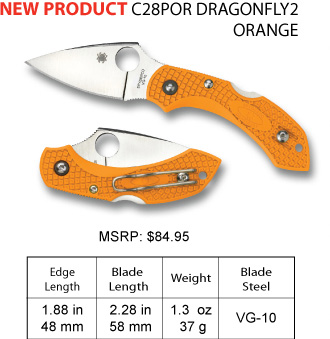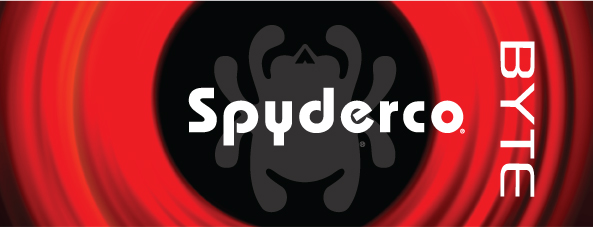
The Dragonfly was one of the first Spyderco knives designed with a handle that is smaller than the hands of most end users, yet still capable of serious cutting performance. It did this through the inclusion of an index-finger “choil.” Also known as a “50/50 choil,” it is essentially a finger groove for the index finger that is created by the shape of the intersection of the blade and handle. It provides a safe, solid purchase for the index finger and positions the hand further forward on the knife. Despite the compact handle, the hand still has a very generous gripping surface that offers both control and cutting power.
Released in 1994, the original Dragonfly was included among Spyderco’s lightweight series of knives. These knives pioneered the use of fiberglass-reinforced-nylon handles and included molded integral pocket clips configured for right-side tip-up carry.
In 1996, the Dragonfly was redesigned to incorporate a number of ergonomic enhancements and the original blade steel, GIN-1, was replaced by AUS-8. Its compact size and full-service cutting ability continued to attract a devoted following and over the years inspired a number of different expressions of the design. These include stainless-steel-handled versions with matching stainless clips and a version with G-10 scales, stainless steel liners and an ambidextrous wire clip. The stainless-handled Dragonfly has also been the palette for Spyderco’s distinctive “tattoo” process—an artistic embellishment of color-filled etchings on the handle.
To accommodate left-handed users and provide truly ambidextrous function, Spyderco’s lightweight knives gradually evolved to incorporate enhanced texture patterns and their molded integral clips were replaced with metal clips. In the case of the Dragonfly Lightweight, this marked the evolution of the Dragonfly2, which features a reversible deep-pocket wire clip that supports ambidextrous tip-up carry. Like the original lightweight model, the Dragonfly2 has been produced in several color variations.
During its history, the Dragonfly has been manufactured with a number of different blade steels. After its early production in GIN-1, AUS-8, and ATS-55, VG-10 became the steel of choice and remains the standard for most versions of the knife today. However, the Dragonfly2 is also available with specialized steels, including ultra-high-carbon ZDP-189 and H-1, an extraordinary nitrogen-based alloy that is completely immune to rust. The H-1 versions of the Dragonfly2, which are members of Spyderco’s Salt series, boast high-visibility bright yellow handles and special corrosion-proof metal clips and other hardware.
The Dragonfly’s versatile leaf-shaped blade was originally produced with a hollow grind, but was changed to a full-flat grind in 1996. With the exception of our H-1 models, which are hollow ground, all other current versions of the design are flat ground. Depending upon the exact model and blade steel, both plain-edged and fully serrated SpyderEdge blades are available.
The Dragonfly and its many variants represent one of the most popular and enduring families of knives in the Spyderco line. It will undoubtedly continue to grow in the future.
|



